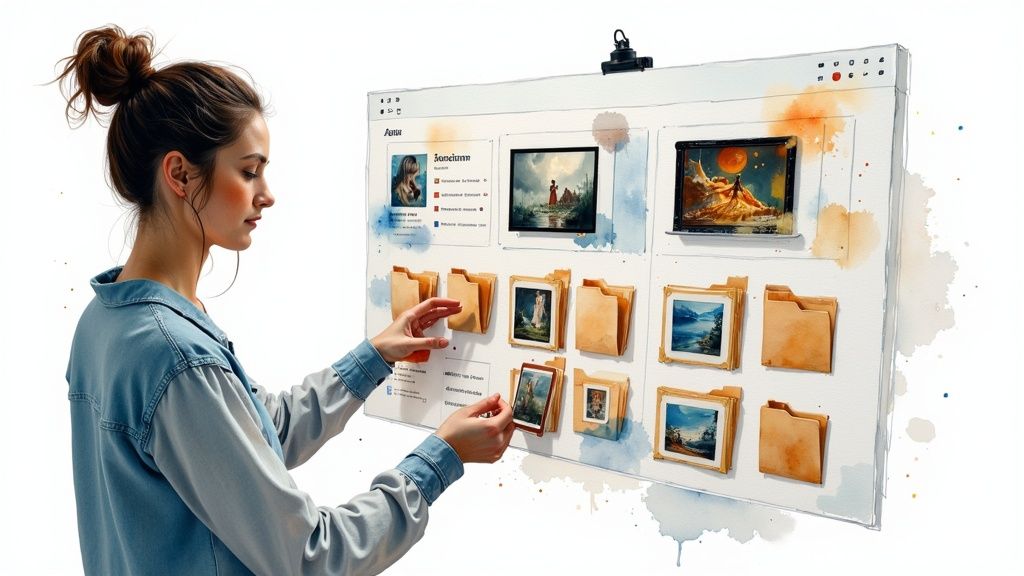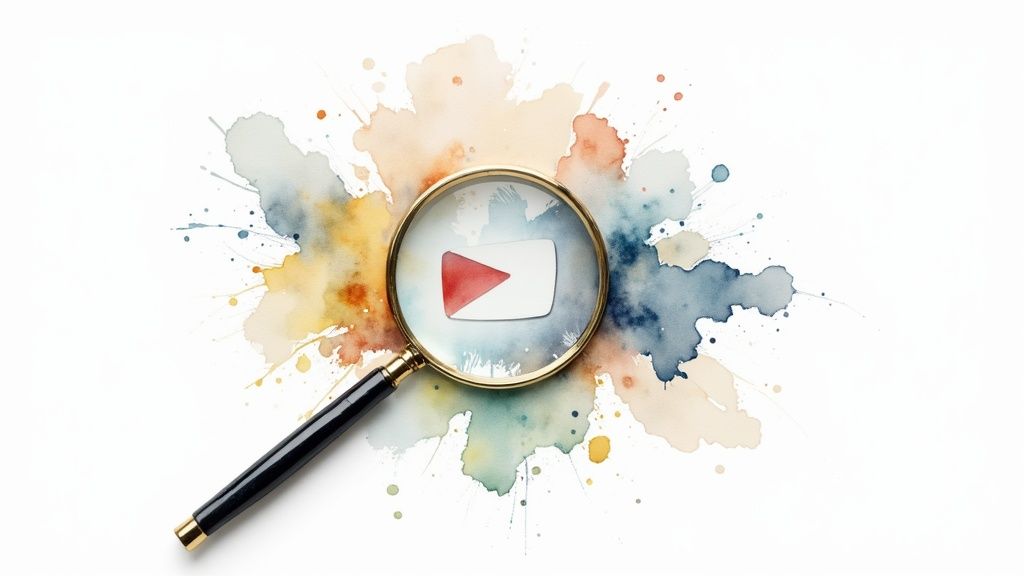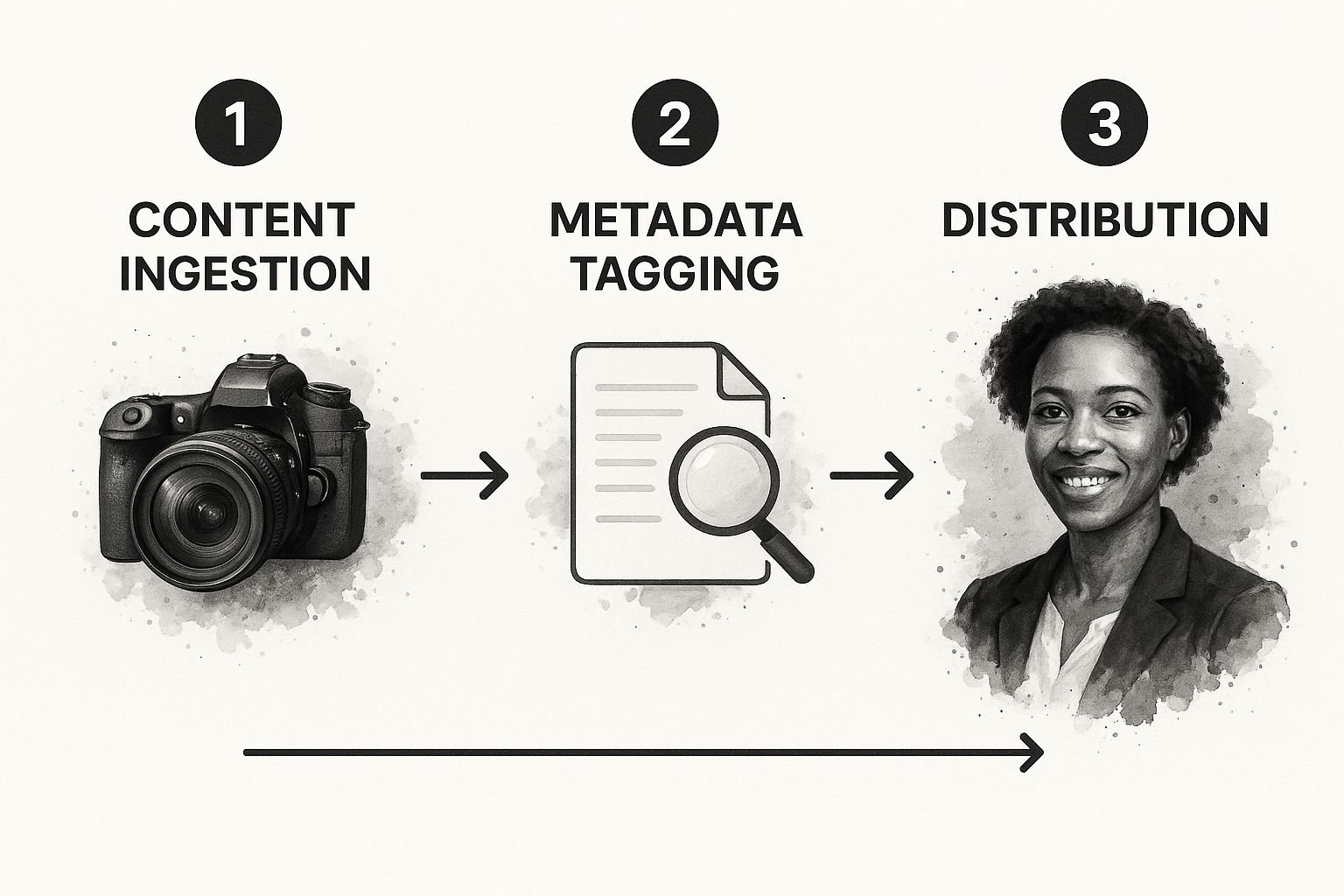In This Article
Subscribe to our newsletter
Is your team drowning in a sea of video files? If so, you’re not alone. Video asset management (VAM) is the system built to rescue you from that digital chaos. Think of it less as storage and more as an intelligent, central library for your most valuable content, making sure every video is secure, easy to find, and ready to go.
Why Video Asset Management Is Essential

If your team constantly asks, "Where’s that video from last quarter's campaign?" you're dealing with a common—and expensive—problem. As your video production ramps up, so does the disorganization. Shared drives quickly turn into digital graveyards, overflowing with duplicate files, old versions, and folders named "Final_Video_v3_USE_THIS_ONE."
This isn't just a minor annoyance; it's a huge drag on your operations. The time your team should be spending creating incredible content is instead wasted on frustrating digital scavenger hunts. A solid video asset management system tackles this problem head-on by creating a single source of truth for your entire video library.
From Digital Mess to Strategic Asset
Imagine a physical library with no card catalog. Books are just piled on the floor, authors are all mixed up, and finding one specific title would be next to impossible. That's exactly how many organizations treat their video files—their most expensive and engaging assets.
A VAM system is your digital librarian. It doesn't just hold onto files; it breathes life into them with data, making every video discoverable and genuinely useful.
- Centralized Access: All your video files live in one secure, cloud-based hub, accessible to the right team members from anywhere.
- Smarter Search: With advanced metadata and tags, you can find a specific clip in seconds, not hours.
- Version Control: Say goodbye to the risk of someone using an outdated or unapproved video. Your brand integrity is protected.
The market is catching on to this critical need. The broader Digital Asset Management (DAM) market, which includes video, was valued at USD 7.73 billion in 2024. It’s projected to explode to USD 31.99 billion by 2033, a surge fueled by remote work and the absolute necessity of content security. You can explore more about these market trends and what they mean for businesses.
A VAM system transforms your video library from a passive, disorganized cost center into an active, strategic asset that drives efficiency and brand consistency.
Solving Critical Workflow Problems
Adopting video asset management is less about buying new software and more about committing to a smarter way of working. It offers straightforward fixes for the persistent headaches that slow down creative and marketing teams.
For any organization that's serious about scaling its video strategy, a VAM isn't a "nice-to-have"—it's a foundational piece of the puzzle. It empowers your team, protects your brand, and ensures you get the best possible return on your huge video production investments. Without it, you’re just creating content that gets lost, losing its value the second it’s saved. A VAM makes sure every video remains a valuable, accessible tool for your business.
Before we dive deeper, let’s look at the specific pain points that a VAM system is designed to eliminate.
Core Problems Solved by Video Asset Management
| Problem Without VAM | Solution With VAM |
|---|---|
| Files are scattered across different drives and platforms, leading to confusion and lost time. | A single, centralized library provides a "single source of truth" for all video assets. |
| Searching for a specific video clip is a manual, time-consuming process that relies on memory. | Advanced metadata and AI-powered tagging make every asset instantly searchable. |
| Team members accidentally use outdated or unapproved video versions, risking brand inconsistency. | Automated version control ensures everyone has access to the latest, approved files. |
| Sharing large video files securely with external partners or clients is difficult and risky. | Secure, permission-based sharing links and portals make collaboration easy and safe. |
These solutions are not just about convenience; they directly impact your team's productivity and your content's overall effectiveness.
The Core Features of a Powerful VAM Platform

What really separates a powerful video asset management platform from a basic cloud storage folder? The difference isn't just about storing files—it's about a handful of intelligent features that bring order to chaos and automate the grunt work.
These features are the engine of your content operation. Instead of just holding files, a true VAM understands your content, protects it, and serves it up to your team in the most useful way possible. Let's dig into the essential features that turn a messy video archive into a high-performing business asset.
AI-Powered Search and Metadata Tagging
The single most game-changing feature of a modern video asset management system is its ability to make content findable. Manually tagging every video with keywords is a soul-crushing, inconsistent chore. This is where artificial intelligence completely changes the equation.
AI-driven tools act like a private search engine for your video library. When you upload a file, the system automatically analyzes it and generates a ton of rich, descriptive metadata. You can learn more about how to bring AI to your company's asset library to see this in action.
Here’s what this AI-powered indexing typically includes:
- Speech-to-Text Transcription: The system transcribes every spoken word in your video, making the dialogue completely searchable. Need to find every clip where the CEO mentions "Q3 results"? Just type it into the search bar.
- Object and Facial Recognition: The AI can spot objects, logos, and even specific people. This is a lifesaver for finding all footage of a certain product or pulling every clip featuring a key spokesperson.
- Scene Detection: Instead of one long file, the platform can intelligently break a video into smaller, logical scenes. This makes it incredibly easy to find and reuse specific moments without scrubbing through hours of footage.
Think of it this way: Without AI metadata, you have a library of unlabeled videotapes. With AI, every single tape is transcribed, indexed, and cross-referenced, so you can find any scene, word, or person in seconds.
Automated Transcoding and Formatting
Your video content needs to look great everywhere—on your website, YouTube, Instagram, LinkedIn, you name it. Each of these platforms demands different file formats, aspect ratios, and resolutions. Having a team member manually create all of these versions is a massive bottleneck.
A VAM platform handles this entire headache with automated transcoding. You upload one high-resolution master file, and the system can automatically generate all the other versions you need—from lightweight proxies for editing to perfectly formatted clips for social media.
This means an editor can work on a small proxy file from home while the marketing team grabs a ready-to-post version for an Instagram campaign. It's all generated from the same source file, saving huge amounts of time and ensuring your brand looks consistent everywhere.
Version Control and Secure Sharing
Collaboration is crucial, but it can get messy. Fast. How do you make sure everyone is working on the latest file? And how do you share works-in-progress with a client without them seeing the wrong cut? This is where version control and secure sharing become indispensable.
Version control is your ultimate safety net. Every time someone uploads a new iteration of a video, the VAM tracks it, keeping a full, accessible history of changes. This finally puts an end to the "Final_v2_FINAL_USE_THIS.mp4" problem and prevents costly mistakes, like publishing an unapproved draft.
Secure sharing gives you total command over who sees what, and when. Instead of sending bulky, insecure email attachments, you can:
- Create share links that are password-protected.
- Set links to expire after a certain date or number of views.
- Assign specific permissions (like view-only vs. download).
- Track exactly who has viewed or downloaded an asset.
Together, these features allow for seamless collaboration with freelancers, agencies, and clients, all while keeping your valuable video asset management library completely locked down.
Key Business Benefits of a VAM Strategy
 Okay, let's get past the features and talk about what really matters: how a video asset management (VAM) strategy actually impacts your business. This isn't just about getting organized; it's a strategic investment that pays off in real, measurable ways across your operations, brand, and revenue.
Okay, let's get past the features and talk about what really matters: how a video asset management (VAM) strategy actually impacts your business. This isn't just about getting organized; it's a strategic investment that pays off in real, measurable ways across your operations, brand, and revenue.
By creating a smart, centralized home for your video, you stop leaking resources and start building real value. Let’s break down the three biggest business benefits a solid VAM strategy delivers for publishers and media companies.
Boost Operational Efficiency
The first and most immediate win you'll see from a VAM is the massive amount of time it gives back to your team. Think about your creatives—editors, marketers, designers. You want them creating, not searching. Without a VAM, they’re stuck wasting hours digging through folders, trying to confirm which file is the final version, or reformatting clips for different social platforms. It's a huge drain.
A VAM system puts all that administrative busywork on autopilot. Suddenly, finding a specific B-roll clip from a shoot two years ago takes seconds, not a frantic afternoon of searching. This time saved translates directly into higher productivity, letting your most expensive talent focus on what they do best.
A VAM acts as a productivity engine, removing the friction from your creative workflow. It empowers teams to work faster, collaborate more smoothly, and produce more high-quality content without increasing headcount.
This operational lift is a huge reason the market is growing so fast. The Media Asset Management (MAM) market, which is all about centralizing these huge multimedia files, was valued at around USD 6.04 billion in 2024. It’s expected to climb to USD 7.22 billion by 2025.
Enforce Rock-Solid Brand Consistency
Your brand's visual identity is one of your most valuable assets. Every time an old logo, an off-brand color grade, or an unapproved video sneaks into the wild, it chips away at audience trust. A messy, disorganized shared drive is almost always the culprit.
A video asset management platform solves this by creating a “single source of truth” for all your visual content. It’s your guarantee that every asset your teams can access is the correct, approved version.
- Version Control: This ensures that only the final, polished version of a video is ever used for publication. No more "final_v2_final_FINAL.mp4" confusion.
- Access Permissions: You get to decide who can see, use, or edit certain assets. This stops unapproved or sensitive content from ever being accidentally published.
- Brand Guidelines: You can attach brand kits and usage rules directly to the assets themselves, so every team member knows exactly how to deploy them correctly.
Centralizing control takes the guesswork and risk out of the equation. This is a crucial step in mastering digital asset management for video and protecting your brand’s reputation as you scale.
Unlock New Revenue Streams
That video archive you're sitting on? It's not just a digital closet of past projects—it’s a potential goldmine. Every piece of footage, from finished campaigns to raw B-roll, is an asset you can repurpose, repackage, or license to generate fresh income. Without an organized system, though, that value is buried and forgotten.
A VAM turns your archive from a dusty shelf into an active, monetizable library. By making every single asset discoverable, you empower your teams to:
- Repurpose Content: Effortlessly find and re-edit old footage into new social media clips, highlight reels, or promos. Achieving content repurposing mastery becomes so much easier when everything is organized and at your fingertips.
- License Footage: Quickly bundle collections of B-roll or stock footage that can be licensed to other companies, opening up an entirely new revenue stream.
- Speed Up Ad Sales: Give your sales team a searchable library of approved ad creative, letting them pull together custom pitches for clients in minutes, not days.
Ultimately, a VAM transforms your content library from a passive cost center into a dynamic, revenue-generating engine for your business.
How to Implement a VAM System
So, you’re ready to get a video asset management (VAM) system. It’s important to know this isn’t like flipping a switch. It’s more like building a solid foundation from the ground up. If you approach it with a clear, step-by-step plan, you’ll end up with a platform that works for you, not against you. A successful rollout brings order to your content library and empowers your teams right from day one.
Think of it like designing a new kitchen. You wouldn't just buy a bunch of appliances and hope they fit. You’d start by taking inventory of what you have, measuring the space, and mapping out where everything should go for maximum efficiency. The same exact logic applies to your video assets.
Start with a Comprehensive Content Audit
Before you can organize anything, you have to know what you’re working with. A content audit is that crucial first step where you take a full inventory of every video file you own. Honestly, this process often uncovers just how scattered and disorganized things have become over time.
Your goal is to map everything out: figure out where files live (is it on shared drives, local hard drives, random cloud storage accounts?), who has access to them, and what the content even is. This audit doesn't have to be perfect down to the last byte, but it should give you a brutally honest picture of the challenge ahead. It’ll also help you get a realistic estimate of the scope for the migration.

As you can see, a VAM's entire workflow hinges on strong metadata tagging. It’s the glue that connects the chaos of ingestion with the clarity of distribution.
Define User Roles and Permissions
Let's be real: not everyone on your team needs access to every single video asset you have. Defining clear user roles and permissions is fundamental for both security and workflow sanity. This simple step prevents those heart-stopping mistakes, like an intern accidentally deleting a master campaign file or a freelancer getting a peek at sensitive, unreleased footage.
Most VAM systems let you get really granular with this. A good starting point is to create groups based on team functions:
- Administrators: They get the keys to the kingdom. Full control over the system, including managing users and tweaking system settings.
- Creators/Editors: These folks can upload, edit, and version assets, but maybe they can't publish the final product.
- Marketers: They can view, download, and share approved assets for their campaigns.
- External Partners: You can grant them temporary, view-only, or download-only access to very specific folders or collections.
By setting these boundaries upfront, you create a secure playground where team members only see and touch the content that’s relevant to their jobs.
Build Your Metadata Strategy and Taxonomy
Okay, this is it. This is the step that makes your video asset management system truly powerful. A taxonomy is the logical structure—the system of folders, categories, and collections—you'll use to organize everything. Your metadata strategy then defines what specific information you'll attach to each file to make it instantly findable.
A good taxonomy is intuitive and scalable. It should make sense to a new employee on their first day and still be effective when your library doubles in size.
Put yourself in your team's shoes. How do they actually search for content? Do they look for a specific campaign name? A product? A filming date? A key speaker? Use these real-world queries to build out your metadata fields.
At a minimum, you'll want to include:
- Project or Campaign Name: The top-level identifier that groups related assets together.
- Asset Type: Clearly label if it's B-roll, a final edit, a social clip, or an interview.
- Usage Rights: This is huge. Specify any licensing restrictions, expiration dates, or talent usage rights.
- Key People or Products: Tag any notable individuals or products featured in the video.
A thoughtful taxonomy and metadata schema are what separate a glorified file storage folder from a high-performance VAM. It’s the framework that actually powers discoverability.
Manage the Migration and Train Your Team
With your structure planned out, you can finally start moving your assets into the new system. Don't try to boil the ocean. Start with your most valuable, frequently used content first. This "high-priority" batch lets your team see the benefits of the VAM right away, which is the best way to get them excited and drive adoption.
But remember, even the most perfect system will fail if nobody knows how to use it properly. Training is not optional. Schedule dedicated sessions to walk your team through the new workflow. Show them exactly how to upload, tag, search, and share assets according to the new rules. A successful rollout depends entirely on enthusiastic user adoption, and that only happens with crystal-clear communication and great training.
Choosing the Right VAM Solution for Your Team
Picking a video asset management (VAM) platform is a major decision, one that will define how your team works for years. This isn't just about grabbing the one with the longest feature list. It’s about finding the right fit for your team's real-world needs, your budget, and where you see yourself growing. Get this right, and you avoid massive headaches and costly migrations down the road.
Think of it like choosing a vehicle for a road trip. A sleek, two-seater sports car looks great, but it’s a disaster for a family of five with a week's worth of luggage. You have to be honest about your needs first—how many people, how much gear, and what kind of roads are you hitting? The same logic applies to your VAM.
Define Your Core Evaluation Criteria
Before you even start browsing vendor websites, stop and create a scorecard. Get your team in a room and agree on what actually matters. This step is your secret weapon for cutting through the marketing noise and focusing on the features that will solve your specific problems.
Every VAM provider will tell you they’re the best. Your scorecard is what tells you who is the best for you.
Start by asking these foundational questions:
- Scalability: Can this platform grow with us? Don't just think about your current video library. Where will it be in two years? Five? A system that’s fine for 1,000 assets might completely fall apart under the weight of 100,000.
- Integration: How well does it play with the tools we already use every day? A good VAM should feel like a natural extension of your workflow, connecting seamlessly to creative software like Adobe Premiere Pro, your marketing platforms, and your content management system (CMS).
- Security: How are you going to protect our most valuable content? Look for robust security protocols like granular user permissions, end-to-end encryption, and secure sharing links to prevent leaks or unauthorized use.
Choosing a VAM is less about picking software and more about investing in a central pillar of your content infrastructure. Prioritize future growth and seamless integration over a flashy but restrictive feature set.
The market for these systems is booming, which shows just how critical they've become. The global Video Management System (VMS) market was valued at around USD 17.12 billion in 2024 and is projected to explode to nearly USD 108.77 billion by 2034. This surge is all about the growing need for organized, secure video libraries across every industry. You can read more about the VMS market growth to get a feel for the trends.
On-Premise vs. Cloud-Based SaaS
One of the first major decisions you'll face is whether to go with an on-premise solution or a cloud-based Software-as-a-Service (SaaS) platform. This choice has huge implications for your costs, maintenance workload, and team accessibility.
An on-premise VAM means you host everything on your own servers. This route gives you absolute control over your data and security protocols, which is often a non-negotiable for organizations in highly regulated fields. The trade-off? You're on the hook for all the maintenance, updates, and hardware costs, which can add up fast.
A cloud-based (SaaS) VAM is hosted by the vendor. This model means lower upfront costs, automatic updates, and the ability to access your library from anywhere with an internet connection. For remote and distributed teams, that flexibility is a game-changer. For most modern media companies, the scalability and ease of a SaaS platform make it the clear winner.
| Factor | On-Premise Solution | Cloud-Based (SaaS) Solution |
|---|---|---|
| Initial Cost | High (hardware, licensing) | Low (subscription-based) |
| Maintenance | Your IT team is responsible | Handled by the vendor |
| Accessibility | Limited to your network | Accessible from anywhere |
| Scalability | Requires buying new hardware | Easily scalable with plan upgrades |
Questions to Ask Every Vendor
Once you have a shortlist, it's time to put these vendors to the test. Don’t be shy—ask the tough questions that get to the heart of your daily workflow.
- Can you demo this using our own files? The best way to judge usability and AI tagging accuracy is to see the platform handle your actual content, not their perfectly curated demo assets.
- What does your support system really look like? Find out their guaranteed response times, what support channels they offer (phone, chat, email), and if you'll get a dedicated account manager.
- How do you handle asset migration? This can be a painful process. Ask for a clear breakdown of their plan for moving your existing library into their system. A true partner will make this as painless as possible.
- How does your platform support video marketing? You need a system that helps with distribution and provides useful analytics. To learn more, check out our guide on using video marketing for e-commerce to boost sales.
By arming yourself with these criteria and questions, you can confidently choose a video asset management partner that doesn’t just clean up today’s mess but also sets your team up for success for years to come.
Got questions about video asset management? You're not alone. Even after grasping the big picture, the practical, day-to-day questions always start to bubble up.
Let's cut through the noise and tackle some of the most common ones. We'll demystify the acronyms and get real about things like cost and impact so you can move forward with confidence.
VAM vs. DAM vs. MAM: What’s the Difference?
It’s easy to get lost in the alphabet soup of asset management. While VAM, DAM, and MAM are all related—and often overlap—they each have a distinct job to do. Knowing the difference is the key to picking the right tool for your team.
Think of it like a mechanic's toolbox. A Digital Asset Management (DAM) system is the big, general-purpose rolling chest. It’s built to hold everything: photos, logos, brand guidelines, presentations, and yes, even video files. It’s the single source of truth for all of a company's digital materials.
A Media Asset Management (MAM) system is more like the specialized drawer for engine work. It’s a subset of a DAM, built for the intense, high-stakes workflows of broadcast and film production. It’s designed to handle massive, high-resolution video files, complex versioning, and the intricate back-and-forth between large creative teams.
Then there's Video Asset Management (VAM). This is the precision toolkit designed specifically for publishers and businesses where video is the main event. A VAM zeroes in on what you actually need, offering the organizational muscle of a DAM but adding powerful, video-centric features like AI-powered transcription, automated transcoding for social media, and deep video analytics. For most marketing and publishing teams, it’s the perfect blend of power and focus.
While a DAM can manage video files, a VAM is purpose-built to do it with far more depth and efficiency. It brings features to the table that are absolutely critical for a modern video strategy but are often overkill or missing entirely in a general-purpose DAM.
How Much Does a VAM System Cost?
Pinning down a single price for a VAM is tough because the cost is almost entirely dependent on your specific needs. Vendors usually have a few common pricing models, and your final bill will be a mix of storage space, the number of users, and the specific features you need.
Most modern VAM platforms run on a Software-as-a-Service (SaaS) model. This means you’re paying a recurring subscription fee instead of a massive one-time cost, which is much more manageable for most businesses.
Here are the usual factors that shape the price tag:
- Storage Tiers: The most basic lever is how much cloud storage you need. This could be a few hundred gigabytes for a small team or multiple terabytes for a large media company.
- User Seats: The cost scales with the number of people on your team who need access. Some platforms charge per user, while others offer bundled packages for teams of different sizes.
- Feature Sets: Many vendors offer tiered plans (think Basic, Pro, and Enterprise). The really powerful tools—like deep AI transcription, custom integrations, or advanced security—are usually reserved for the higher-priced tiers.
For a small-to-medium-sized business, you should budget anywhere from a few hundred to a few thousand dollars per month. The most important thing is to find a provider with scalable plans. You want to be able to start with what you need today and grow into more advanced features later without having to go through a painful migration.
Can a VAM Help with Video SEO?
Absolutely. While a video asset management system isn't a traditional SEO tool like Ahrefs or SEMrush, it plays a powerful, behind-the-scenes role in boosting your video's search visibility.
Think about it: search engines like Google and YouTube are data-hungry machines. They rely on metadata and text to understand what a video is about, and a VAM is a system built specifically for creating, organizing, and deploying that very data.
A well-organized VAM helps your video SEO efforts in two main ways. First, it brings order to your metadata chaos. By making it dead simple to manage titles, descriptions, and tags in one place, you’re far more likely to apply SEO best practices consistently across all your videos.
Second, it makes your content much more accessible and ready for distribution. Here’s how that translates to better SEO:
- Organized Metadata: A VAM acts as your command center for video titles, descriptions, and keywords. This discipline makes it easy to execute a consistent SEO strategy across every video you publish.
- AI-Generated Transcripts: The transcripts automatically generated by a VAM are SEO gold. You can instantly repurpose them as closed captions or even as the foundation for a full blog post. This gives search engines a rich, text-based version of your video to crawl, dramatically improving its chances of ranking for all the relevant keywords spoken in the video.
- Streamlined Publishing: When it’s easy to find the right video and format it for different platforms (your blog, YouTube, social media), you’re more likely to publish it widely. This creates more backlinks and social signals pointing to your content—all crucial ranking factors.
In short, by making your video library an organized and accessible powerhouse, a VAM helps you execute a stronger, more consistent, and ultimately more successful video SEO strategy.
Ready to transform your content workflow? Aeon provides a powerful, AI-driven platform to create, manage, and distribute high-quality video content at scale. Stop searching and start creating. Discover Aeon today.






.jpg)